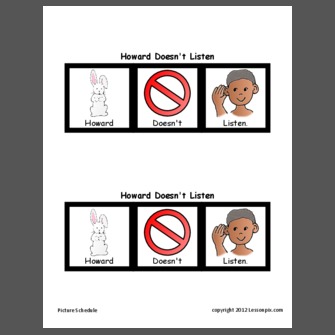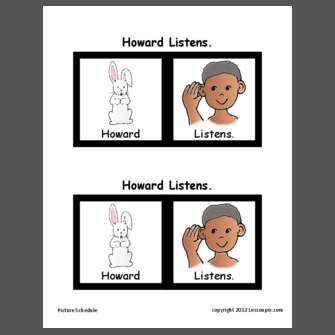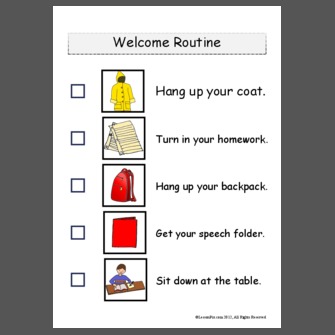For this post, I am sharing with you the lesson that I am using for
the beginning of the school year. This lesson aligns with common core and meets a
variety of language goals. I am including links to mindwingconcepts.com, Amazon.com, and lessonpix.com for
your convenience.
I work primarily with Preschoolers and kindergarteners, and as
of yet, there are no common core standards for preschool. But I think the standards for Kindergarten
give me a good framework for what to work towards.
This lesson will address the following kindergarten standards:
CCSS.ELA-Literacy.SL.K.2
Confirm understanding of a text read aloud or information presented orally or
through other media by asking and answering questions about key details and
requesting clarification if something is not understood.
CCSS.ELA-Literacy.SL.K.4
Describe familiar people, places, things, and events and, with prompting and
support, provide additional detail.
This lesson also addresses IEP goals focusing on direction following, increasing MLU, vocabulary, answering “wh” questions, sentence structure, and story narrative.
Materials:
Braidy The Storybraid (or The Story Grammar
Marker) from mindwingconcepts.com.
Howard Wigglebottom Learns to Listen
by Howard Binkow and illustrated by Susan Cornelison.
Sentence Strips: “Howard doesn’t
listen.” “Howard learns to listen.” I made my sentence strips from lessonpix.com.
Howard Wiggle Bottom is an adorable
story that tells about a little rabbit named Howard and his adventures in
school. He struggles with listening to his teacher and to his friends, which
create problems for all involved. Eventually he is asked to take a time
out. Howard decides to listen and is
positively reinforced for his good listening behavior. This is a good book for the beginning of the
school year, because it helps children recognize appropriate and inappropriate
behavior in the classroom session.
This book also lends itself well to
story retell as it is a complete episode.
However, the book’s audience is younger children who are just beginning
their school year. In addition, some of
the children I work with have not been exposed to the StoryBraidy and are not developmentally ready for the later stages of story retell. Time
will need to be spent at the beginning stages.
Step 1:
Review or introduce the concept of
Character.
The manual for the Storybraid comes with excellent lessons on how to teach the concept of character. While I do adjust the lessons to meet the needs of my students and teachers, I do follow the order and structure.
The manual for the Storybraid comes with excellent lessons on how to teach the concept of character. While I do adjust the lessons to meet the needs of my students and teachers, I do follow the order and structure.
For my non-verbal/newly verbal
students, I will address basic concepts of pointing to body parts (i.e. eyes,
face and head.) I do hand over hand with them if necessary, but I work towards
having them point or touch eyes and head on both the Braidy Doll and on
themselves independently. I also work
on naming body parts.
Students using short
phrases and following 1 step directions will begin identifying characters. I begin asking questions such as “Are you a
character?” “Am I a character?” “Is your friend a character?” “Is your pet a character?” We are beginning to answer “who” questions. We begin discussion the physical traits of a
character (has eyes, face, and head) and the fact that a character can “do”
things.
For students that
already have exposure to Braidy, we will also talk about setting in terms of
place. We begin to answer “Where”
Questions. “Where are you?” “Is a school
a setting?”
Step 2:
Read and then talk about the book.
Read and then talk about the book.
For my non-verbal and
newly verbal students I have them begin to point to images in the book. They point to Howard, to his friends, to the
teacher and to his friends. We begin
working on naming items in the book.
For my students using
short phrases, we will begin answering “who” questions and answering in complete
short sentence.
“Who is the Character?”
“Howard is a character.”
For
my older students, we will also begin to answer “Where” questions?
“Where
is Howard?”
“Howard
is at school.”
“Howard
is in the classroom.”
“Howard
is in the cafeteria.”
“Howard
is on the playground.”
Step 3:
Review the book and use sentence strips.
Review the book and use sentence strips.
For my non-verbal and
newly verbal students I will have them point to the picture as I say the
words. I use hand over hand if necessary
to help them understand what I want.
My students short
MLU’s will work on using contractions and verb conjugation. I work on having them point independently while saying the words of
the sentence, but I also model it if necessary.
For my older students
we look at the words under the picture to address print recognition.
For me, the majority of my language
therapy is done in the classroom. In
each classroom, I am likely to have students at every level and need to be able
to meet all of their needs at once. I typically see my students for
two 30 minutes sessions and I recruit the classroom staff to help me with the
lessons. I will probably repeat this
lesson 4 to 6 times, reducing my support and increasing student independence.


























